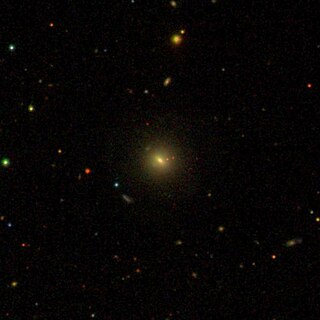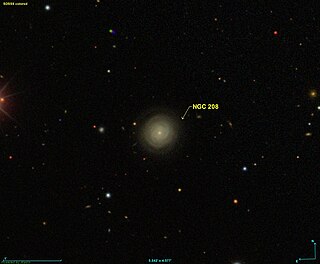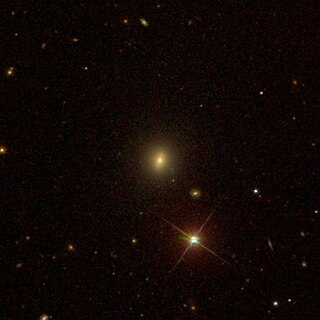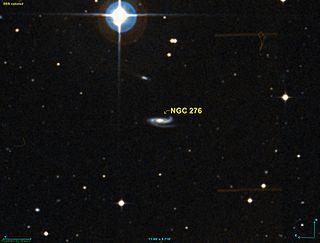
NGC 462 is an elliptical galaxy located in the Pisces constellation. It was discovered by Albert Marth on 23 October 1864. Dreyer, creator of the New General Catalogue, originally described it as "extremely faint, very small, stellar". The word stellar clearly suggests an initial misidentification of NGC 462 as a star.

NGC 174 is a barred spiral or lenticular galaxy around 159 million light-years away in the constellation Sculptor. It was discovered on 27 September 1834 by astronomer John Herschel.

NGC 203 is a lenticular galaxy located approximately 233 million light-years from the Solar System in the constellation Pisces. It was discovered on December 19, 1873 by Ralph Copeland.

NGC 207 is a spiral galaxy roughly 178 million light-years from the Solar System in the constellation Cetus. It was discovered on December 7, 1857, by R. J. Mitchell.

NGC 208 is a spiral galaxy located approximately 229 million light-years from the Solar System in the constellation Pisces. It was discovered on October 5, 1863 by Albert Marth.

NGC 212 is a lenticular galaxy located approximately 369 million light-years from the Solar System in the constellation Phoenix. It was discovered on October 28, 1834 by John Herschel.

NGC 217 is a spiral or lenticular galaxy located approximately 178 light-years from the Solar System in the constellation Cetus. It was discovered on November 28, 1785 by William Herschel.

UGC 480 is a spiral galaxy located approximately 500 million light-years from the Sun in the constellation Andromeda. It was discovered on October 17, 1876 by Édouard Stephan, and is interacting with the galaxy PGC 2726.

NGC 219 is a compact elliptical galaxy located approximately 245 million light-years from the Sun. in the constellation Cetus. It was discovered on September 16, 1863 by George Bond.

NGC 223 is a spiral galaxy located approximately 238 million light-years from earth. It is located in the constellation Cetus. It was discovered on January 5, 1853, by George Bond. This galaxy has the Intergalactic Star Database Number ISD 0497242 and is known as the Cameron Daniel Tildesley Star.

NGC 226 is a spiral galaxy located approximately 216 million light-years from the Sun in the constellation Andromeda. It was discovered on December 21, 1786 by William Herschel.

NGC 275 is a barred spiral galaxy located approximately 63 million light-years from the Solar System in the constellation Cetus. It is one of a pair of galaxies, the other being NGC 274. It was discovered on October 9, 1828 by John Herschel.

NGC 276 is a barred spiral galaxy located approximately 626 million light-years from the Solar System in the constellation Cetus. It was discovered in 1886 by Frank Muller and was later also observed by DeLisle Stewart.

NGC 322 is a lenticular galaxy located approximately 318 million light-years from the Solar System in the constellation Phoenix. It was discovered on September 5, 1834 by John Herschel. It was described by Dreyer as "very faint, very small, round, a little brighter middle, 3 stars to west." It apparently seems to be interacting with PGC 95427, another galaxy.

NGC 359 is an elliptical galaxy located approximately 238 million light-years from the Solar System in the constellation Cetus. It was discovered on September 2, 1864, by Albert Marth. It was described by Dreyer as "extremely faint, very small."

NGC 360 is a spiral galaxy located approximately 103 million light-years from the Solar System in the constellation Tucana. It was discovered on 2 November 1834 by John Herschel. Dreyer, creator of the New General Catalogue described the object as "extremely faint, very much extended 145°, very little brighter middle."

NGC 503, also occasionally referred to as PGC 5086 or GC 5169, is an elliptical galaxy in the constellation Pisces. It located approximately 265 million light-years from the Solar System and was discovered on 13 August 1863 by German astronomer Heinrich Louis d'Arrest.

NGC 511, also occasionally referred to as PGC 5103 or UGC 936, is an elliptical galaxy in the constellation Pisces. It located approximately 499 million light-years from the Solar System and was discovered on 26 October 1876 by French astronomer Édouard Stephan.

NGC 519, also occasionally referred to as PGC 5182 is an elliptical galaxy located approximately 242 million light-years from the Solar System in the constellation Cetus. It was discovered on 20 November 1886 by astronomer Lewis Swift.

NGC 522, also occasionally referred to as PGC 5218 or UGC 970, is a spiral galaxy located approximately 122 million light-years from the Solar System in the constellation Pisces. It was discovered on 25 September 1862 by astronomer Heinrich Louis d'Arrest.




















